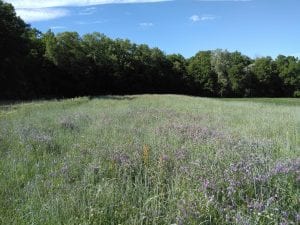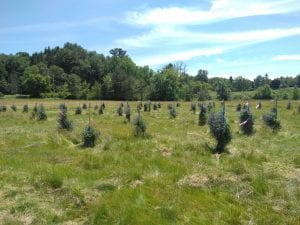Hi all, my name is Matthew Spoth and this summer I am interning for Matthew Ryan in the Sustainable Cropping Systems Lab. The summer is flying by and it is probably because of how much fun I have been having at work. Every week I am assisting with a different task, and it is exciting to watch all of our research plots progress.

Perennial Grain plot where we managed the vetch by hand weeding to keep the farmers happy!(vetch is the purple color you can see)
Over the next several decades, our environmental stability is going to diminish due to changes in climate. Concurrently, our global population and the demand for production will be exponentially increasing. As a brief overview, the lab focuses on advancing sustainable crop production practices. We do this through researching radical and exciting ideas such as perennial small grains, ecological weed management, intercropping for increased resilience, interseeding, rotational no-till practices, cover crop breeding and much more. Another large part of the lab is conducting farmer interviews to determine socioeconomic factors that influence the use of ecological farming practices. This is only a fraction of what we do and I cannot wait to share more throughout the rest of the summer.
Today I would like to talk about Hairy Vetch in our legume cover crop breeding trials, as well as my encounters with it in our perennial grain test plots. As I go home and explain my internship to my family who farms in Erie county, this piece of my internship always surprises them because Hairy Vetch is commonly known as a vigorous and competitive weed that you do not want to see in your fields. It can be serious problem, especially in fall sown small grains such as winter wheat. In our on-farm perennial grain test plots, I have seen a single plant spread out 4 feet in diameter. However, when used as a cover crop and intentionally seeded in early September, hairy vetch can overwinter and provide over 100 lb nitrogen per acre to subsequent crops planted in June. The competitiveness of hairy vetch is what makes it both a bad weed as well as a good cover crop. As a cover crop, it can smother weeds and reduce weed seed production; however, it can also smother crop plants and reduce yields when is it growing as a weed.
Our legume cover crop breeding project is a multi-site project, with sites in Maryland, North Carolina, Minnesota, and here in New York. We use traditional breeding techniques select for desirable traits. In addition to large amounts of biomass and vigor, some organic farmers are interested in early flowering and using hairy vetch for organic no-till production. This system involves mechanically killing the cover crop with a roller-crimper. Hairy vetch can be effectively killed without herbicides by rolling it when it is at the late flowering/early pod stage. Thus, organic farmers want early flowering varieties that will allow them to terminate the hairy vetch with a roller-crimper in May instead of June and no-till plant corn into the residue. Farmers are also very interested in reducing hard seededness (i.e., dormancy) in hairy vetch, as this trait leads to hairy vetch persistence in the soil seedbank and emergence at unwanted times such as during the wheat phase of a crop rotation.
My tasks in helping with the experiment included helping to trellis the plants, install deer fences, take meristem clips for DNA sequencing and eventually harvesting the seed pods.



